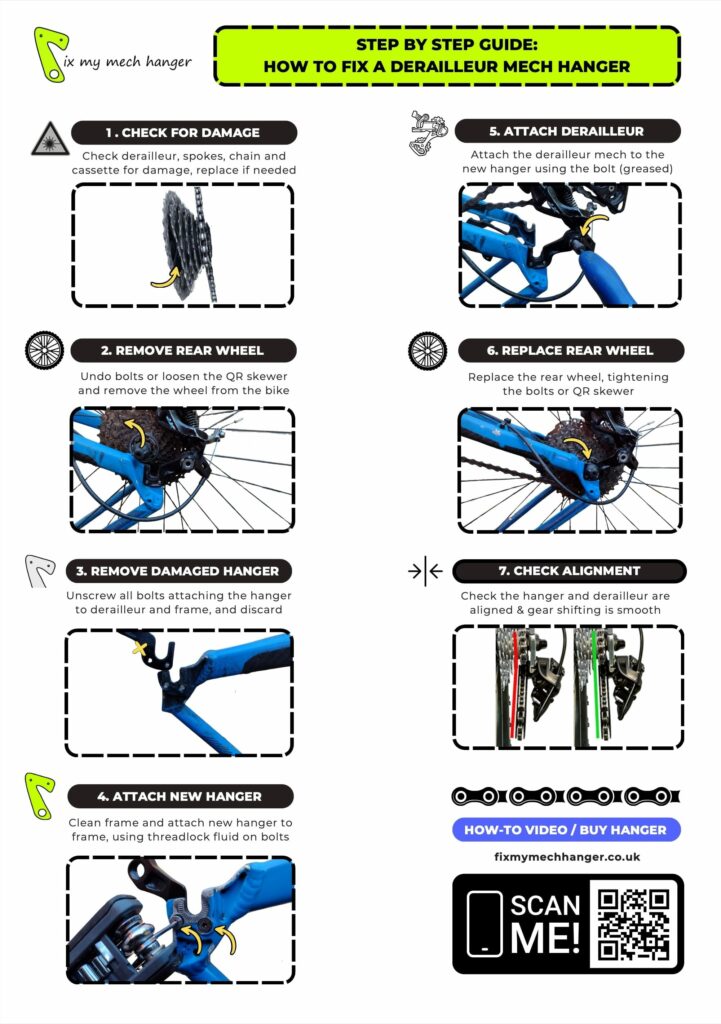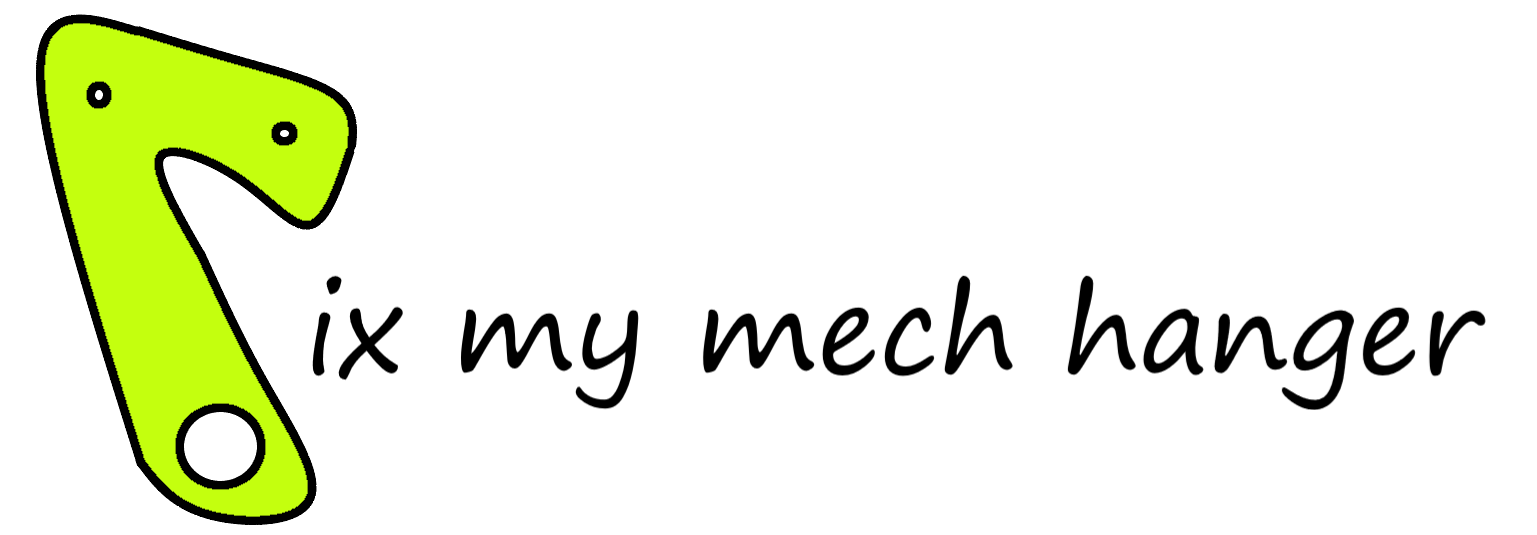How to identify a rear mech derailleur hanger?
If you need to buy a new hanger, follow these steps to identify your hanger, in order of simplicity:
- Search by bike brand / manufacturer, then look for a visual match: On this website, scroll to the bottom of the page and simply click on the brand / manufacturer of your bike to see a list of hangers, and look for a visual match of you old / broken hanger. Pay attention to the shape and screw holes to make sure they are exactly the same.
- Look for the part number: Check your old / broken hanger or in your bike manual for a part number, this can help to confirm you have the correct hanger.
- Match your bike model and year: If you’re still unsure, you can check the description of the hanger for which bike model and year it fits. This can sometimes be helpful, although this is less reliable (than step 1) as sometimes the information is a bit of of date, and a hanger may fit more recent bike despite it not being named in the product description.
How to fix a broken derailleur hanger
If you’ve got your replacement hanger ready to go, fixing it is a straightforward job. If you need help, you can either watch the video or download the PDF instructions.
Download the printable PDF instruction sheet with pictures :
How to straighten a bent rear mech derailleur hanger?
For aluminium or carbon frames, the answer is : Don’t bother. You may expect a business selling rear mech derailleur hanger to say this, but speaking as a degree educated professional mechanical engineer, it’s really not worth the risk.
Hangers are made from aluminium which when deformed plastically (technical definition!) weakens the structure of the metal. It may be possible to straighten a very slightly bent hanger to get you home, but you need to replace the hanger as soon as you can, since the hanger will be weaker, not be quite the right shape or will be slightly out of alignment making it much more likely to snap the next time.
For steel framed bikes, these usually have a rear mech derailleur hanger integrated into the frame as they can be bent back into shape as steel is less brittle and more able to withstand bending back and forth (although this shouldn’t be done too much). To straighten integrated steel mech hangers, you’ll need a derailleur hanger alignment tool, as its important this is correct so shifting is smooth and the derailleur is not put under additional stress again.
Why do rear mech derailleur hangers bend or break?
If you’ve just broken your mech hanger, it’s very disheartening to realise you can’t use your bike again until you get a replacement – BUT – you should take some joy from knowing that your mech hanger has done its job by saving your expensive carbon or aluminium frame from damage by acting as a sacrificial, easily replaceable part! If your hanger was built into your frame and it broke, you’d need to replace the entire frame.
There are a few different causes of mech hangers breaking or bending:
- A problem which causes your chain to snag while pedalling. Another half turn of the cranks will not move the chain, but pull the whole derailleur assembly around and finally break the hanger.
- Chain snagging could be caused by: the chain itself breaking and becoming caught in the cassette or front chainrings; damage to the cassette or front chainrings themselves; some debris caught in the drivetrain.
- If your derailleur end stop is not adjusted correctly, the derailleur or chain can crash into the spokes and become entangled, and the hanger will break.
- Accident damage when you crash and the weight of the bike (and you!) is taken by the derailleur.
- In transit when the wheels have been removed and the bike is not packed sufficiently and the weight of the bike or other items are resting on the derailleur.
Things to look out for to stop it happening again:
- Always check your derailleur, chain, cassette, chainrings and spokes after a broken mech hanger. Often just the mech hanger itself breaks but damage to these other components could either have caused or resulted from a broken mech hanger.
Why does my rear mech derailleur hanger keep breaking?
The purpose of a rear mech derailleur hanger is to protect the frame from damage in case of an accident or mishap by breaking or bending. If your derailleur hanger keeps breaking, there are several potential reasons for this recurring issue:
1. Impact or Crash Damage: If you’ve had an accident or impact on the rear derailleur, the hanger might have incurred damage.
2. Shifting Issues: Sometimes, excessive force on the gears, such as changing gear under high load, or a problem where the chain gets stuck due to debris or a other damaged drivetrain components, can put extra strain on the derailleur hanger, causing it to break prematurely.
3. Bent or Misaligned Hanger: Even a slight bend or misalignment in the derailleur hanger can cause shifting issues and increase stress on the hanger. A bent hanger will not only impact shifting performance but can also weaken the part, leading to breakage.
The good news is that derailleur mech hangers are easy and inexpensive to replace, but to ensure you are not repeatedly breaking your hanger, you can take the following steps:
- Clean your bike drivetrain regularly
- Check the hanger regularly too – don’t try to bend back a replaceable hanger, just replace it.
- Check other components, and replace any damaged ones, the most likely are: bent derailleur cages and best cassette teeth.
- Change your shifting technique – you’ll hear crunching sounds if you change gears while pedaling hard which isn’t great for your chain or cassette but can also impact on the longevity of your hanger
Why do you need a rear mech derailleur hanger?
- Protecting Your Bike: The primary function of a derailleur hanger is to act as a sacrificial component. If your bike hits a rock or takes a hard fall, the derailleur hanger is designed to bend or break first, protecting more vital and expensive components like the rear derailleur and the aluminium or carbon bike frame from severe damage.
- Ensuring Smooth Gear Shifting: The derailleur mech hanger holds the rear derailleur in place, allowing it to move the chain between gears smoothly. A slightly bent or damaged hanger can lead to misaligned gears, causing problems with shifting or even chain loss.
- Easy and Cost-Effective to fix: Derailleur mech hangers are designed to be easily replaceable. They are relatively inexpensive compared to other bike components, so having a spare one in your repair kit is a smart move. If your hanger gets damaged during a ride, you can quickly replace it and get back on track without much hassle.
While the derailleur hanger might be one of the smallest components of your bike, it does a vital job and so it’s important to always carry a spare.
Is there a universal rear mech derailleur hanger?
Short answer: No!
Long answer: There’s at least 2 ‘universal’ rear mech / derailleur hangers, but they are not suitable for every bike
- There is emergency mech hanger which can be used on most bikes with a quick release (QR) hub and axle. This hanger might be useful if you often ride with others and want to have a spare if others in your group have a broken hanger. It’s meant as a temporary hanger just to get you home, and it’s unlikely you’ll be able to use the full range of gears on your cassette – however it’s better than walking home!
- A few years ago SRAM introduced their ‘Universal Derailleur Hanger’. It’s designed to rotate rearward in the event of impact and features the ability to “re-rail” the chain back onto the small cog. It works with MTB and E-MTB derailleurs from different manufacturers. However … you must have a bike with a frame specifically designed for this hanger – just like any other bike! You can buy one from us here: https://fixmymechhanger.co.uk/product/sram-universal-derailleur-hanger/
How much does it cost to fix a rear mech derailleur hanger?
To do it yourself, it can be as little as the cost of the replacement derailleur mech hanger, which are between about £5 and £30. But you’ll need to check your other components for damage, and if you need to replace your derailleur or chain for example, or if you ask your local bike shop to do the job, then this will obviously cost more.
